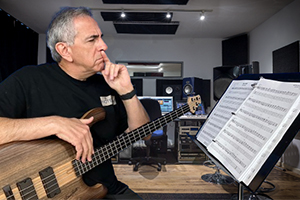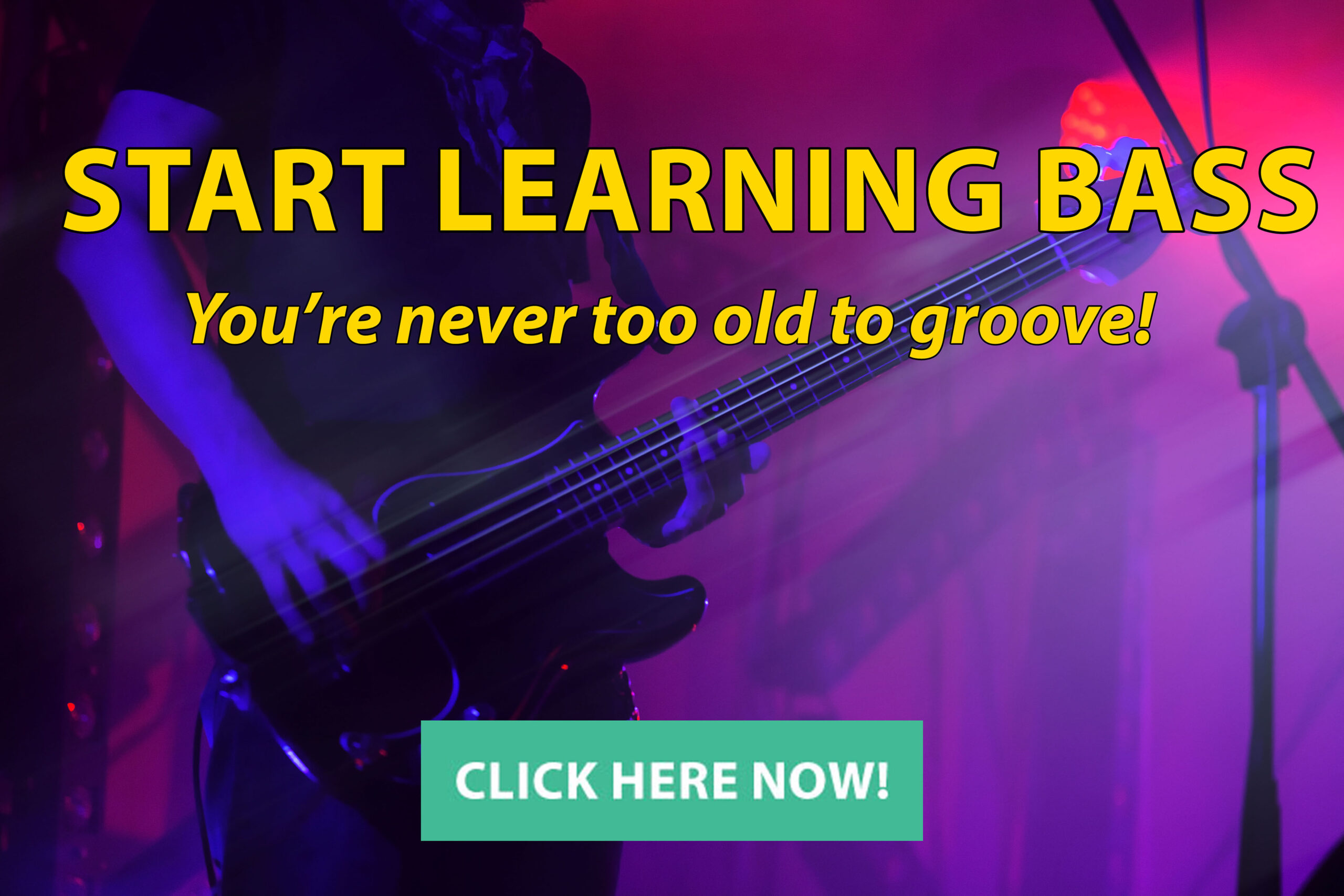When was the last time you were on a gig and someone handed you a chart with tab?
By Jon Liebman
February 9, 2024
I love getting input and feedback from my students at For Bass Players Only. And I get a lot of it (maybe because I ask them a lot of questions).
One of the things many people want to learn on the bass is how to read music.
Thinking back to the start of my book-writing days in the late ‘80s/early ‘90s, I was told by my publisher, Hal Leonard, that including tab in all my books was a must.
Several years later, when I launched my online bass instruction program on For Bass Players Only, I instinctively followed suit and included tab in all the lessons.
Is tab good or bad?
While a lot of my students appreciate, even depend on having tab, others tell me they find it to be a distraction and a nuisance. Some are even covering it up with tape.
That’s when I started included tab-free versions in my Bottom Line Club membership and in my just-published digital course, Bass Guitar for the Rocker in You!
FYI, that’s I addition to tab, not instead.
The topic still comes up from time, as it did in this week’s interview with awesome bassist and educator Paul Thompson.
“Learning how to read,” Paul says, “even on a very rudimental level, will change your whole thing. It will open this door that I can’t even describe.”
But what about tab?
“I get a lot of requests from people (that) want me to do tabs,” Paul says. “I don’t do tab on my videos because I’ve never gotten on a gig and had someone hand me tab. Not yet anyway!”
Don’t fight it
Is there a resistance to learning to read music the traditional way?
“I’m reading so much stuff online right now about people, specifically bass players who aren’t professionals, that are trying to play more and learn more,” Paul says, adding that they “are very reticent about learning how to read music on the staff.”
I wonder why. Is it because it takes too much time or involves too much work?
“Any amount of reading will help you,” Paul says.
And the advantages of learning to read without tab far outweigh the time and effort that goes into it.
The (sometimes obvious, sometimes not) benefits of learning to read without tab
“Reading music on any level will open up your universe,” says Paul. “It will make your musical circle bigger and allow you to take more steps.”
What’s more, he says, it will provide a lot of great opportunities.
“It will open up the whole history of the music to you,” he says, “and it’ll allow you to play with people you never thought you could play with.”
Paul’s not talking about picking up the Charlie Parker Omnibook and blazing through Bird’s ridiculously complicated bebop solos. Even the simple stuff will take you a long way.
“Just a little bit of reading ability opens up so much for you,” he says, “especially for people who have gotten to an older age and haven’t had to deal with it.”
Did you know this about Jaco?
According to Paul, learning to read music even did wonders for Jaco’s career.
“Jaco was restless,” Paul says. “Jaco was a genius who couldn’t read. He was gigging all over the place. He could already do these incredible things on the bass, and when he started learning how to read, which he did later than most of us, his music just got greater and he started writing symphonic pieces and learning Bach. And it just got greater and greater and greater and greater.”
Tab has it benefits. But use it responsibly.
I told Paul I don’t mind if my students consult the tab if they’re unsure about something, as long as they don’t rely on it as a crutch.
“If you think about it this way,” he says, “tab is a chart, just like reading music. It’s a chart. It’s a graph that shows you what notes to play when and where. And tab is exactly the same thing. You’re just reading a graph with numbers instead of dots. I see it as a very small step that opens a big door.”
How about you?
I often talk about people who’ve been “meaning” to learn how to read music, without tab, but haven’t gotten there yet. Are you included in that group? Either way, leave a comment below and share your story. And be sure to watch my interview with Paul here.


As a younger person and throughout my life, I had difficulty reading music. I called it music dyslexia. In my 60’s I used EZplay
Music to play an electric key board.
Now, at 86, I am playing the bass guitar.
I started with IRealPro and also translate the musical notes to letters (C, D, E etc).
I have also created a code where I translate the musical notes into fractions,
the upper number identifying the fret line and the lower number identifying the string.
5/2 would mean the 5th fret and the 2 would mean the second string (the A string) creating the D tone. This is similar to tabs, but put into numbers. I am able to immediately identify where to play the note.
I’ve been playing since ‘69 and never learned how to sight read. I can read slowly if need be. Unfortunately my brain cabinet doesn’t have much storage space left. I have had a lousy memory since childhood and it doesn’t improve with age.
I’ve been playing professionally and teaching for 55 years. Couldn’t agree more. As I commented some time ago, reading notation unlocks the “mystery” of the fingerboard like nothing else and forces you to think about rhythm in an analytical way that improves your understanding and groove feel. Like Paul I have never been given a tab chart on a bandstand or in a studio.
I think I did fight or minimize reading for a long time. My ability to hear and just play it maybe made me feel I would be fine. Then I was asked to sit and play for some keyboard player because they lost the drummer and the bass player had to move to the drums. This keyboard player was writing his own stuff. Didn’t know me and so I show up and he hands me the sheet of what he wants. Oh boy. So I went back to basics. I don’t play with him anymore, but I am improved.
I learned to read music but bass only.
I prefer it to tab which I find gets in the way of reading music. I try to avoid tab when I can.
However I can not read and play music at the same time. I lose focus
I think part of the issue with reading is that those who dont, and then try, are going about it all wrong in terms of how reading is conceived by many (especially amateur) musicians. First, they arent patient enough. Learning how to read at a basic level, on any instrument, can take a year, maybe two, but reading music is something we should always be doing, for as long as we play. In social media groups I read posts of many beginning bassists who think they are going to sit down and learn to read as if it were doing a landscaping project over the weekend. Nothing could be more unrealistic. When I first started playing bass at age 13, my teacher started me out using a book where the first exercises were to play open E quarter notes, then open A quarter notes, then open D quarter notes, then open G quarter notes, all written out on a staff. That was week one! As a kid I didnt question this. The next lessons built on that, with added notes and increasing rhythmic complexity. I was doing reading exercises at every lesson, for years, using the Simandl books (on electric bass) in the beginning, then moving on to etudes of all varieties, and then transcribing jazz solos, and reading and playing in big bands and pit orchestras. So, reading should not be conceived as a “thing” we learn to do, after which we check it off the list. It’s an ongoing activity that should be built into everything we practice and do on the instrument. Reading is a tool that is in constant use in the practice room though. Do I memorize most of the music I play at gigs? Yes. I’m a big advocate of memorizing music too, especially if we are going to perform it repeatedly, such as wedding gig repertoire, or jazz standards, or a band where the music is original.
Great info, David. I love how seriously you take it. Thanks for the well-thought-out comment!